Provenance, Depositional Environment, and Paleoclimatic Conditions of a Near-Source Fan Delta: A Case Study of the Permian Jiamuhe Formation in the Shawan Sag, Junggar Basin
Abstract
:1. Introduction
2. Geological Setting
3. Methods and Dataset
4. Results
4.1. Provenances
4.1.1. Seismic Reflection Characteristics
4.1.2. Petrography
4.1.3. Trace and Rare Earth Element Characteristics
4.2. Heavy Mineral Characteristics
4.2.1. Q-Type Cluster Analysis of the Heavy Minerals
4.2.2. MDS and PCA of the Heavy Minerals
4.3. Lithofacies and Lithofacies Associations
4.4. Baiyang River Section of the Architecture
4.5. Sedimentary Facies
5. Discussion
5.1. Redox Conditions and Paleoclimatic Information
5.1.1. Paleoredox Conditions
5.1.2. Paleoclimatic Considerations
5.2. Tectonic Setting and Provenance
5.2.1. Tectonic Setting Restoration Based on the Elements
5.2.2. Indicative Significance of the Provenance System
6. Conclusions
- According to the compositional analysis, the study area mainly consists of lithic feldspar sandstone. The trace elements (La/Sc, Th/Sc, and La/Sc-Co/Th) confirm that the provenance belongs to the acid island arc. The seismic progradational reflection, which indicated flows from the northwest to the southeast. Through a Q-type cluster analysis and the MDS and PCA results of the heavy minerals analysis, the provenance of the study area could be divided into four zones. There are significant differences in the heavy mineral contents in these four zones. This phenomenon reflects the movement of sedimentary debris from the source to a sink, which is affected by a series of processes, such as exposed weathering, denudation, sediment transportation, decomposition, and recrystallization.
- We considered the lithology, texture, internal arrangement, and geometry of the core and the Baiyang River section and underwater/distributary channels, and they were well defined by ten kinds of lithofacies and three lithofacies associations. FA-1 is composed of Gmg, Gcm, and Gcs, and a scouring surface and “floating clasts” are typical identification marks. FA-2 is composed of Gcm, Gcs, Gg/Gi, and St/Sm and is characterized by the directional arrangement of gravel, reflecting a depositional environment with stable hydrodynamic conditions. FA-3 consists of the pyroclastic flow (>50%) of sedimentary rocks with breccia, which indicated the volcanic facies, and it could be seen locally in the northern area of the study area.
- Weak reduction, semi-humid, and semi-dry conditions are evidenced by the Th/U, V/(V+ Ni), V/Cr, Cu/Zn, Sr/Ba, and Sr/Cu values in the Jiamuhe Formation. Alternating wet and dry periods influenced the sedimentological and petrographic characteristics of the sandstones and mudstones.
- Based on the petrography, La/Sc and Th/Sc values, tectonic provenance plots (Hf-La/Th), REE models, and trace element La/Sc-Co/Th identification maps, the tectonic setting of the Shawan Sag is a continental island arc, which is mainly characterized by eruptive facies. This result supports the interbedded sedimentary strata of the volcanic rock and gravelly sandstone that have developed in the Jiamuhe Formation.
Author Contributions
Funding
Data Availability Statement
Acknowledgments
Conflicts of Interest
References
- Weltje, G.J.; von Eynatten, H. Quantitative provenance analysis of sediments: Review and outlook. Sediment. Geol. 2004, 171, 1–11. [Google Scholar] [CrossRef]
- Scheffler, K.; Buehmann, D.; Schwark, L. Analysis of late Palaeozoic glacial to postglacial sedimentary successions in South Africa by geochemical proxies–Response to climate evolution and sedimentary environment. Palaeogeogr. Palaeoclimatol. Palaeoecol. 2006, 240, 184–203. [Google Scholar] [CrossRef]
- El-Bialy, M.Z. Geochemistry of the neoproterozoic metasediments of Malhaq and Um Zariq Formations, Kid metamorphic complex, Sinai, Egypt: Implications for source-area weathering, provenance, recycling, and depositional tectonic setting. Lithos 2013, 175, 68–85. [Google Scholar] [CrossRef]
- Meinhold, G.; Howard, J.P.; Strogen, D.; Kaye, M.D.; Abutarruma, Y.; Elgadry, M.; Thusu, S.; Whitham, A.G. Hydrocarbon source rock potential and elemental composition of lower Silurian subsurface shales of the eastern Murzuq Basin, Southern Libya. Mar. Petrol. Geol. 2013, 48, 224–246. [Google Scholar] [CrossRef]
- He, D.; Lv, Q.; Zhang, Y.; Zhang, P.; Pei, F.; Zhang, X. Paleosedimentary environment evolution during the Middle-Late Permian in the western slope of Songliao basin and its petroleum geological implications. Acta Geol. Sin. 2022, 96, 1–16. [Google Scholar]
- Zhang, Z.B.; Xu, Y.; Miao, Y.J.; Wang, W.F.; Zhao, D.F.; Chen, L.D. Provenance and sedimentary environment of Paleogene Gongjue Formation in Qamdo Basin. Acta Sedimentol. Sin. 2022, 40, 1561–1581. [Google Scholar]
- Awan, R.S.; Liu, C.L.; Gong, H.W.; Dun, C.; Tong, C.; Chamssidini, L. Paleo-sedimentary environment in relation to enrichment of organic matter of early cambrian black rocks of Niutitang Formation from Xiangxi area China. Mar. Petrol. Geol. 2020, 112, 104057. [Google Scholar] [CrossRef]
- Aléon, J.; Chaussidon, M.; Marty, B.; Schütz, L.; Jaenicke, R. Oxygen isotopes in single micrometer-sized quartz grains: Tracing the source of Saharan dust over long-distance atmospheric transport. Geochim. Cosmochim. Acta 2002, 66, 3351–3365. [Google Scholar] [CrossRef]
- Armas, P.; Moreno, C.; Sánchez, M.L.; González, F. Sedimentary palaeoenvironment, petrography, provenance and diagenetic inference of the Anacleto Formation in the Neuquén Basin, Late cretaceous, Argentina. J. S. Am. Earth Sci. 2014, 53, 59–76. [Google Scholar] [CrossRef]
- Xu, J.; Jiang, Z. Provenance analysis of clastic rocks: Current research status and prospect. J. Palaeogeogr. 2019, 21, 379–396. [Google Scholar]
- Wang, J.; Hu, X.; Huang, Z. Provenance analysis of late cretaceous-early eocene sandstones in the sangdanlin area, Southern Tibet. Acta Geol. Sin. 2008, 82, 92–103. [Google Scholar]
- Jiang, T.; Cao, L.; Xie, X.; Wang, Z.; Li, X.; Zhang, Y.; Zhang, D.; Sun, H. Insights from heavy minerals and zircon U–Pb ages into the middle Miocene–Pliocene provenance evolution of the Yinggehai Basin, northwestern South China Sea. Sediment. Geol. 2015, 327, 32–42. [Google Scholar] [CrossRef]
- Carrapa, B. Resolving tectonic problems by dating detrital minerals. Geology 2010, 38, 191–192. [Google Scholar] [CrossRef]
- Chen, L.; Yang, Y.; Wang, F.; Lu, H.; Zhang, Y.; Xin, W.; Yanping, L.; Chen, L. Exploration history and enlightenment in Junggar Basin. Xinjiang Pet. Geol. 2020, 41, 505–518. [Google Scholar]
- Liang, Y.S.; He, D.; Zhen, Y.; Zhang, L.; Tian, A. Tectono-stratigraphic sequence and basin evolution of Shawan Sag in the Junggar Basin. Oil Gas Geol. 2018, 39, 943–954. [Google Scholar]
- Li, E.; Jin, J.; Wang, J.; Ma, W.; Chen, S.; Liu, C.; Wang, H. Geochemical characteristics and genesis of mid-to-shallow natural gas on the periphery of Shawan Sag, Jungger Basin. Oil Gas Geol. 2022, 43, 175–185. [Google Scholar]
- Li, Y.; Lu, J.; Liu, X.; Wang, J.; Chen, S.; He, Q. Geochemical characteristics of source rocks and gas exploration direction in Shawan Sag, Junggar Basin. Nat. Gas Geosci. 2022, 33, 1319–1331. [Google Scholar] [CrossRef]
- Guan, X.; Pan, S.X.; Qu, Y.Q.; Xu, D.N.; Zhang, H.; Ma, Y.P.; Wang, G.; Chen, X.Z. Discovery and hydrocarbon exploration potential of beach-barsand in Shawan Sag, Junggar Basin. Lithol. Reserv. 2021, 33, 90–98. [Google Scholar]
- Li, Y.J.; Xu, Q.; Liu, J.; Wang, R.; Xiang, K. Redefinition and geological significance of Jiamuhe Formation in Hala’alate mountain of West Junggar, Xinjiang. J. Earth Sci. 2016, 41, 1479–1488. [Google Scholar]
- Liu, J. Research on Permian in the Hala’alate Mountain, West Junggar. Master’s Thesis, Chang’an University, Xi’an, China, 2015. [Google Scholar]
- Lu, Y. Permian Chronostratigraphic Framework and Sedimentary Filling Evolution in Mahu-Shawan and Adjacent Area, Junggar Basin. Master’s Thesis, China University of Geosciences, Beijing, China, 2018. [Google Scholar]
- Wu, Q. Development stage, Structural unit division and local structural genesis of Junggar Basin. Xinjiang Pet. Geol. 2018, 7, 29–37. [Google Scholar]
- Carroll, A.R.; Yunhai, L.; Graham, S.A.; Xuchang, X.; Hendrix, M.S.; Jinchi, C.; McKnight, C.L. Junggar basin, northwest China: Trapped Late Paleozoic ocean. Tectonophysics 1990, 181, 1–14. [Google Scholar] [CrossRef]
- Cai, Z.; Chen, F.; Jia, Z. Types and tectonic evolution of Junggar Basin. Earth Sci. Front. 2000, 7, 431–440. [Google Scholar]
- Xiao, F.F.; Hou, G.T.; Wang, Y.X.; Li, L. Study on structural stress fields since permian, Junggar Basin and adjacent areas. Acta Sci. Nat. Univ. Pekin. 2010, 46, 224–230. [Google Scholar]
- Li, G.; Qin, J.; Xian, C.; Fan, X.; Zhang, J.; Ding, Y. Theoretical understandings, key technologies and practices of tight conglomerate oilfield efficient development: A case study of the Mahu oilfield, Junggar Basin, NW China. Pet. Explor. Dev. 2020, 47, 1185–1197. [Google Scholar] [CrossRef]
- Miall, A.D. The Geology of Fluvial Deposits; Springer: Berlin/Heidelberg, Germany, 1996. [Google Scholar]
- Zhao, J.; Chen, X. Dualoptimization of seismic attributes based on principal component analysis and K-L transform. Geophys. Geochem. Explor. 2005, 29, 253–256. [Google Scholar]
- Kruskal, J.B. Nonmetric multidimensional scaling: A numerical method. Psychometrika 1964, 29, 115–129. [Google Scholar] [CrossRef]
- Aitchison, J. Principal component analysis of compositional data. Biometrika 1983, 70, 57–65. [Google Scholar] [CrossRef]
- Taylor, S.R. An examination of the geochemical record preserved in sedimentary rocks. In The Continental Crust: Its Composition and Evolution; Blackwell Scientific Pub: Hoboken, NJ, USA, 1985; Volume 312. [Google Scholar]
- Bhatia, M.R.; Crook, K.A.W. Trace element characteristics of graywackes and tectonic setting discrimination of sedimentary basins. Contrib. Mineral. Petrol. 1986, 92, 181–193. [Google Scholar] [CrossRef]
- Rudnick, R.; Gao, S. Composition of the continental crust. In Treatise on Geochemistry; Holland, H., Turekina, K.K., Eds.; Elsevier: Amsterdam, The Netherlands, 2014; pp. 1–51. [Google Scholar]
- Yu, H.T.; Liu, X.Y.; Wu, B.W.; Liu, X.M. Large fan delta control factors of upper wuerhe Formation of Shawan sag in Northwest margin of Junggar Basin. Xinjiang Geol. 2020, 38, 71–76. [Google Scholar]
- Hui, X.; Hou, Y.; Yu, J.; Long, S.; Guo, Y.; Liu, Y.; Zhang, J. Progradational seismic strata features and distribution of sandstone in the deep-water area of a large-scale lacustrine depression basin: A case study of the middle Yanchang Formation in Longdong, Ordos basin. Acta Sedimentol. Sin. 2022, 40, 787–800. [Google Scholar]
- Wang, J.; Wu, C.; Li, Z.; Zhu, W.; Zhou, T.; Wu, J.; Wang, J. Whole-rock geochemistry and zircon Hf isotope of Late Carboniferous–Triassic sediments in the Bogda region, NW China: Clues for provenance and tectonic setting. Geol. J. 2018, 54, 1853–1877. [Google Scholar] [CrossRef]
- Wu, S.; Liang, Y.; Zhang, L.; Tian, A. Tectonic transition relationship between Shawan sag and western Well Pen-1 sag and its geological significance. Xinjiang Pet. Geol. 2018, 39, 277–284. [Google Scholar]
- Mclennan, S.M.; Hemming, S.R.; Taylor, S.R.; Eriksson, K.A. Early proterozoic crustal evolution: Geochemical and NdPb isotopic evidence from metasedimentary rocks, southwestern North America. Geochim. Cosmochim. Acta 1995, 59, 1153–1177. [Google Scholar] [CrossRef]
- Wang, J.; Wang, S.; Deng, Z. Survey on challenges in clustering analysis research. Control Decis. 2012, 27, 321–328. [Google Scholar]
- Torgerson, W.S. Theory and Methods of Scaling; John Wiley & Sons: New York, NY, USA, 1958. [Google Scholar]
- Gan, Z.; Zhou, F.; Xiao, Y. Study on the algorithm for multidimensional scaling. J. Tsinghua Univ. 1991, 31, 20–27. [Google Scholar]
- He, K. A Method for Fault Diagnosis Based on Multidimensional Scaling and Neural Network in Power Electronic Circuit. Master’s Thesis, Hefei University of Technology, Hefei, China, 2018. [Google Scholar]
- Wei, Z.; Li, X.; Sinclair, H.; Fan, X.; Wang, J.; Zhang, C.; Jiebu, G. The embryonic Himalayan foreland basin revealed in the eastern Yarlung Zangbo suture zone, southeastern Tibet. Sediment. Geol. 2020, 407, 105743. [Google Scholar] [CrossRef]
- Miall, A. The Geology of Fluvial Deposits: Sedimentary Facies, Basin Analysis and Petroleum Geology; Springer: New York, NY, USA, 1996; Volume 575. [Google Scholar]
- Tan, C.; Yu, X.; Qu, J.; Wang, Z.; Li, X.; Gao, Z. Complicated conglomerate lithofacies and their effects on hydrocarbons. Pet. Sci. Technol. 2014, 32, 2746–2754. [Google Scholar] [CrossRef]
- Yao, Z.; Li, S.; Yu, X.; Deleqiati, J.; Yang, F.; Wang, W.; Akedan, S.; Yang, X.; Zheng, B.; Li, L.; et al. Effects of the interaction of tectonics, eustasy, climate, and minerals on the sedimentary evolution of early-middle Jurassic in the Hongshanzui region in Junggar Basin. J. Pet. Sci. Eng. 2021, 196, 107967. [Google Scholar] [CrossRef]
- Pyros, A.; Pujalte, V.; Schmitz, B. Mid-latitude alluvial and hydroclimatic changes during the Paleocene–Eocene Thermal Maximum as recorded in the Tremp-Graus Basin, Spain. Sediment. Geol. 2022, 435, 106–155. [Google Scholar] [CrossRef]
- Martini, L.; Leckie, D. Anatomy and evolution of a Lower Creta-ceous alluvial plain: Sedimentology and palaeosols in the upper BlairmoreGroup, south-western Alberta, Canada. Sedimentology 1997, 44, 197–220. [Google Scholar]
- Li, F.; Li, D.; Deng, X.; Liu, Z.; Wang, F.; Li, S.; Wang, Z. The microfacies architecture of delta front along gentle slope zone of Yanchang Formation in Huachi Area, Shanxi-Gansu-Ningxia Basin. Acta Sedimentol. Sin. 2002, 20, 582–587. [Google Scholar]
- Zhang, Y.; Qi, X.; Cheng, X.; Luo, Z. Approach to sedimentary environment of late Carbniferous-Permian in Junggar Basin. Xinjiang Pet. Geol. 2007, 28, 673–675. [Google Scholar]
- Zhao, Y.; Xiao, L. Coupling between the permian volcanic--sedimentary sequences and the basin evolution in the Western Junggar Foreland Basin. Geol. Rev. 2000, 46, 530–535. [Google Scholar]
- Du Jinhu, Z.D.; Yong, T.; Chunming, J.; Yang, X. Prospects in Upper Permian and strategic discovery in Shawan sag, Junggar Basin. China Pet. Explor. 2019, 24, 24–35. [Google Scholar]
- Allen, J.L.; Johnson, C.L. Facies control on sandstone composition (and influence of statistical methods on interpretations) in the John Henry Member, Straight Cliffs Formation, Southern Utah, USA. Sediment. Geol. 2010, 230, 60–76. [Google Scholar] [CrossRef]
- Rimmer, S.M.; Thompson, J.A.; Goodnight, S.A.; Robl, T.L. Multiple controls on the preservation of organic matter in Devonian–Mississippian marine black shales: Geochemical and petrographic evidence. Palaeogeogr. Palaeoclimatol. Palaeoecol. 2004, 215, 125–154. [Google Scholar] [CrossRef]
- Kimura, H.; Watanabe, Y. Oceanic anoxia at the Precambrian-Cambrian boundary. Geology 2001, 29, 995–998. [Google Scholar] [CrossRef]
- Cullers, R.L. The controls on the major and trace element variation of shales, siltstones, and sandstones of pennsylvanian-permian age from uplifted continental blocks in colorado to platform sediment in Kansas, USA. Geochim. Cosmochim. Acta 1994, 58, 4955–4972. [Google Scholar] [CrossRef]
- Zhang, M.; Liu, Z.; Xu, S.; Sun, P.; Hu, X. Element response to the ancient lake information and its evolution history of argillaceous source rocks in the Lucaogou Formation in Sangonghe area of southern margin of Junggar Basin. J. Earth Sci. 2013, 24, 987–996. [Google Scholar] [CrossRef]
- Wignall, P.B.; Twitchett, R.J. Oceanic anoxia and the end permian mass extinction. Science 1996, 272, 1155–1158. [Google Scholar] [CrossRef]
- Bryn, J.; Manning, D.A. Comparison of geochemical indices used for the interpretation of palaeoredox conditions in ancient mudstones. Chem. Geol. 1994, 111, 111–129. [Google Scholar]
- Therrien, F. Palaeoenvironments of the latest cretaceous (Maastrichtian) dinosaurs of Romania: Insights from fluvial deposits and paleosols of the Transylvanian and Haeg basins. Palaeogeogr. Palaeoclimatol. Palaeoecol. 2005, 218, 15–56. [Google Scholar] [CrossRef]
- Opluštil, S.; Lojka, R.; Rosenau, N.A.; Strnad, L.; Sýkorová, I. Middle Moscovian climate of eastern equatorial Pangea re.orded in paleosols and fluvial architecture. Palaeogeogr. Palaeoclimatol. Palaeoecol. 2015, 440, 328–352. [Google Scholar] [CrossRef]
- Bercovici, A.; Cui, Y.; Forel, M.B.; Yu, J.; Vajda, V. Terrestrial paleoenvironment characterization across the Permian–Triassic boundary in South China. J. Asian Earth Sci. 2015, 98, 225–246. [Google Scholar] [CrossRef]
- Chen, L.; Guo, F.; Steel, R.J.; Li, Y. Petrography and geochemistry of the late cretaceous redbeds in the Gan-Hang Belt, southeast China: Implications for provenance, source weathering, and tectonic setting. Int. Geol. Rev. 2016, 58, 1196–1214. [Google Scholar] [CrossRef]
- Tian, Y.; Zhao, X.; Wang, L.; Tu, B.; Xie, G.; Zeng, B. Geochemistry of clastic rocks from the Triassic Xujiahe Formation, Lichuan area, southwestern Hubei: Implications for weathering, provenance and tectonic setting. Acta Petrol. Sin. 2015, 31, 261–272. [Google Scholar]
- Bhatia, M.R. Rare earth element geochemistry of Australian Paleozoic graywackes and mudrocks: Provenance and tectonic control. Sediment. Geol. 1985, 45, 97–113. [Google Scholar] [CrossRef]
- Xiong, T.; Dang, Y.; Jia, C.; Li, S.; Shang, C. High-resolution sequence architecture and sandbody distribution prediction of fan delta: A case study of upper wuerhe Formation of Permian in west slope of shawan Sag. J. Xi’an Shiyou Univ. Nat. Sci. Ed. 2021, 36, 16–22. [Google Scholar]
- Xu, M.; Wei, X.; Yang, R.; Wang, P.; Cheng, X. Research progress of provenance tracing method for heavy mineral analysis. Adv. Earth Sci. 2021, 36, 154–171. [Google Scholar]
- Morton, A.C.; Hallsworth, C.R. Processes controlling the composition of heavy mineral assemblages in sandstones. Sediment. Geol. 1999, 124, 3–29. [Google Scholar] [CrossRef]
- Zhao, H.; Liu, C. Approaches and prospects of provenance analysis. Acta Sedimentol. Sin. 2003, 21, 409–415. [Google Scholar]
- Song, K.; Lv, J.; Du, J.; Wang, H. Source direction analysis and delta depositional systems of yanchang Formation of the upper Triassic in the central Ordos Basin. J. Palaeogeogr. 2002, 4, 59–66. [Google Scholar]

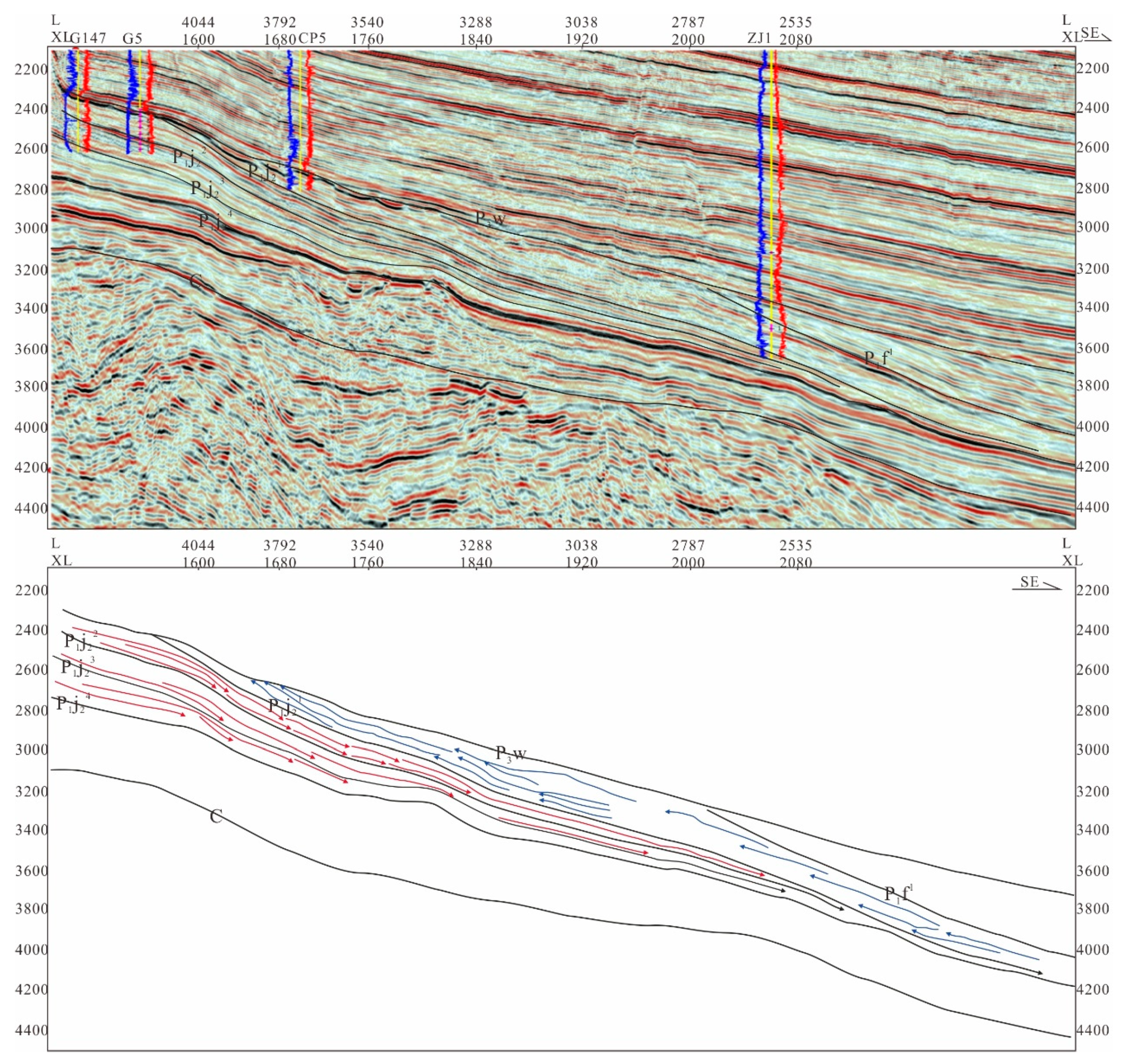
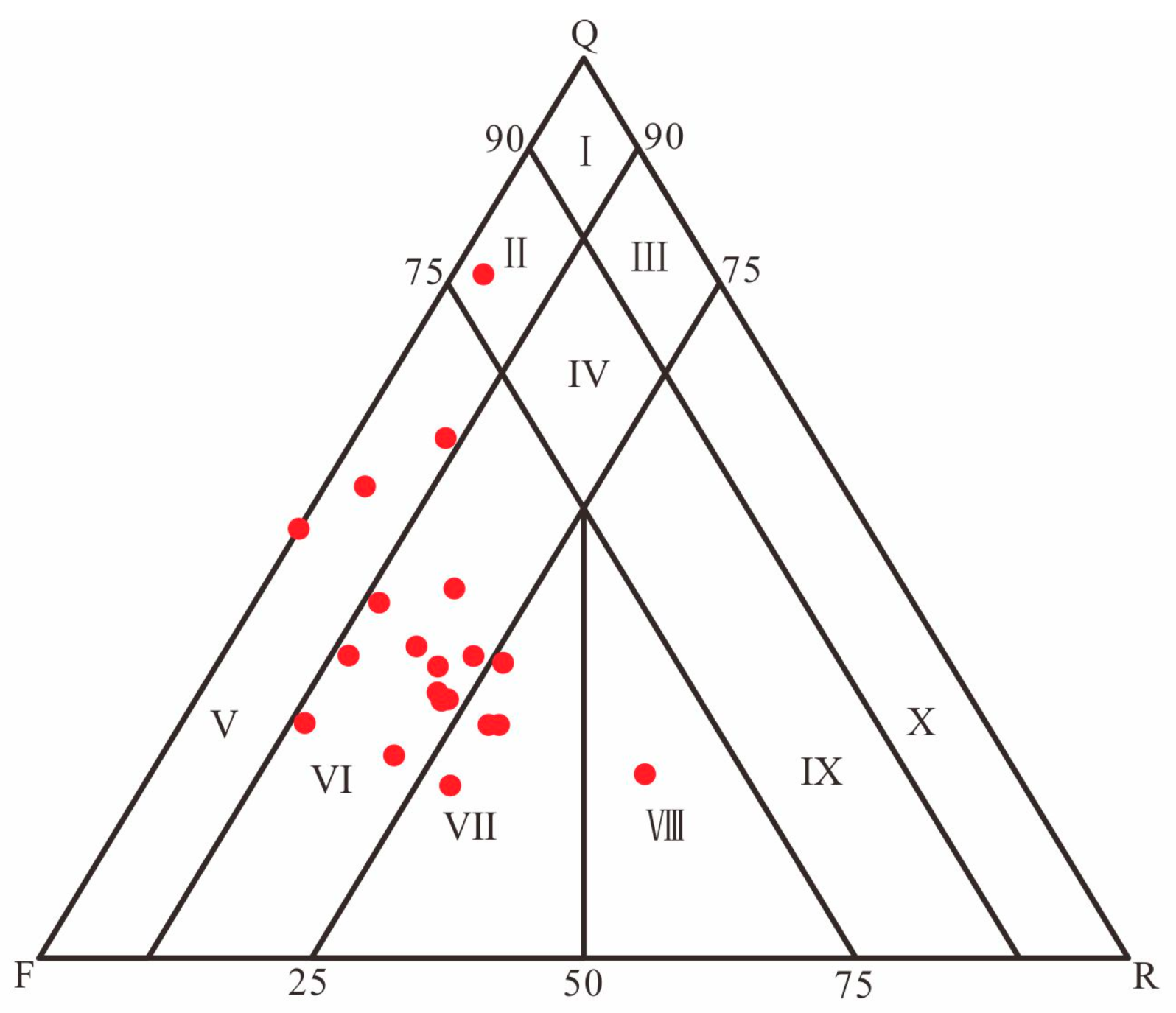
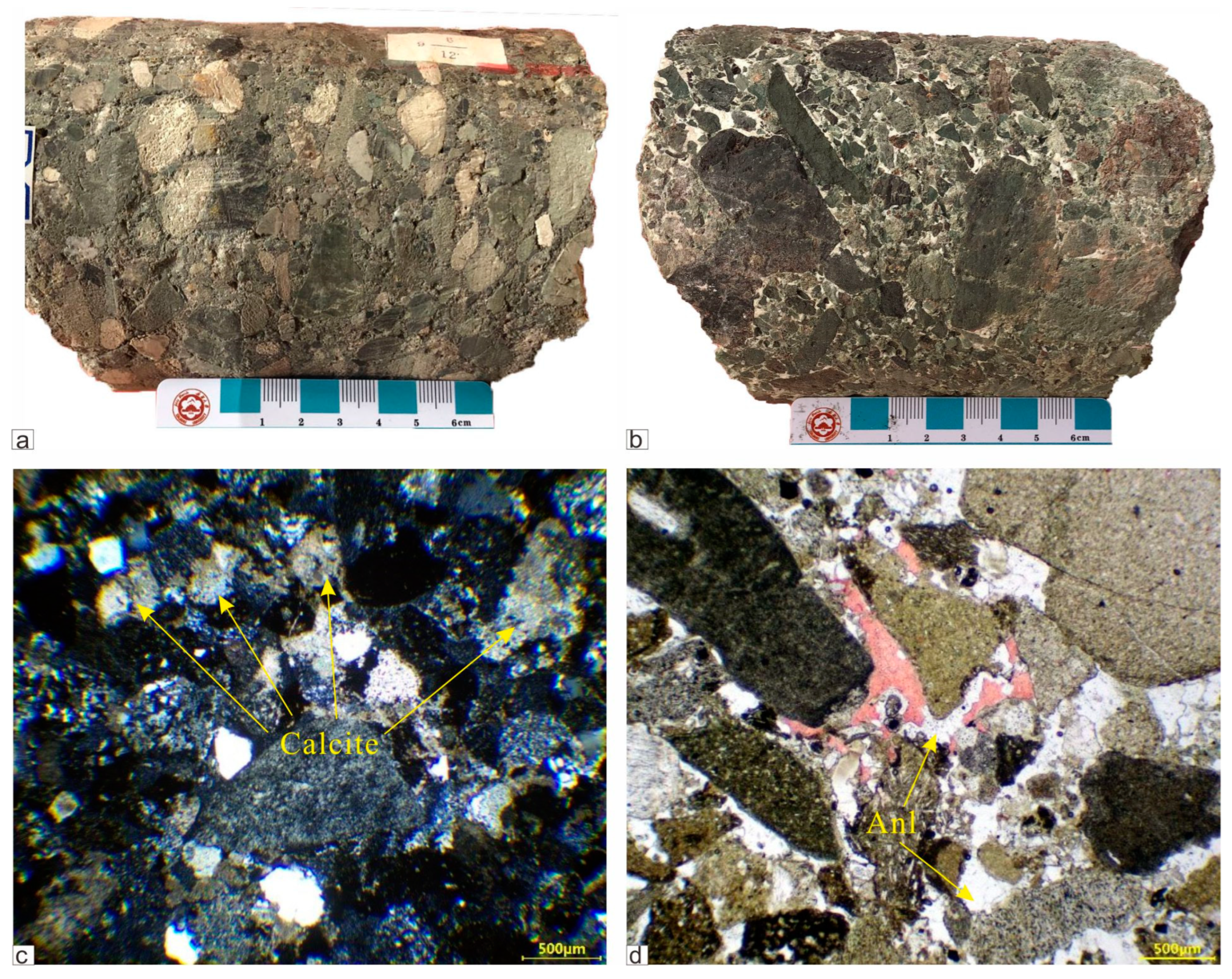

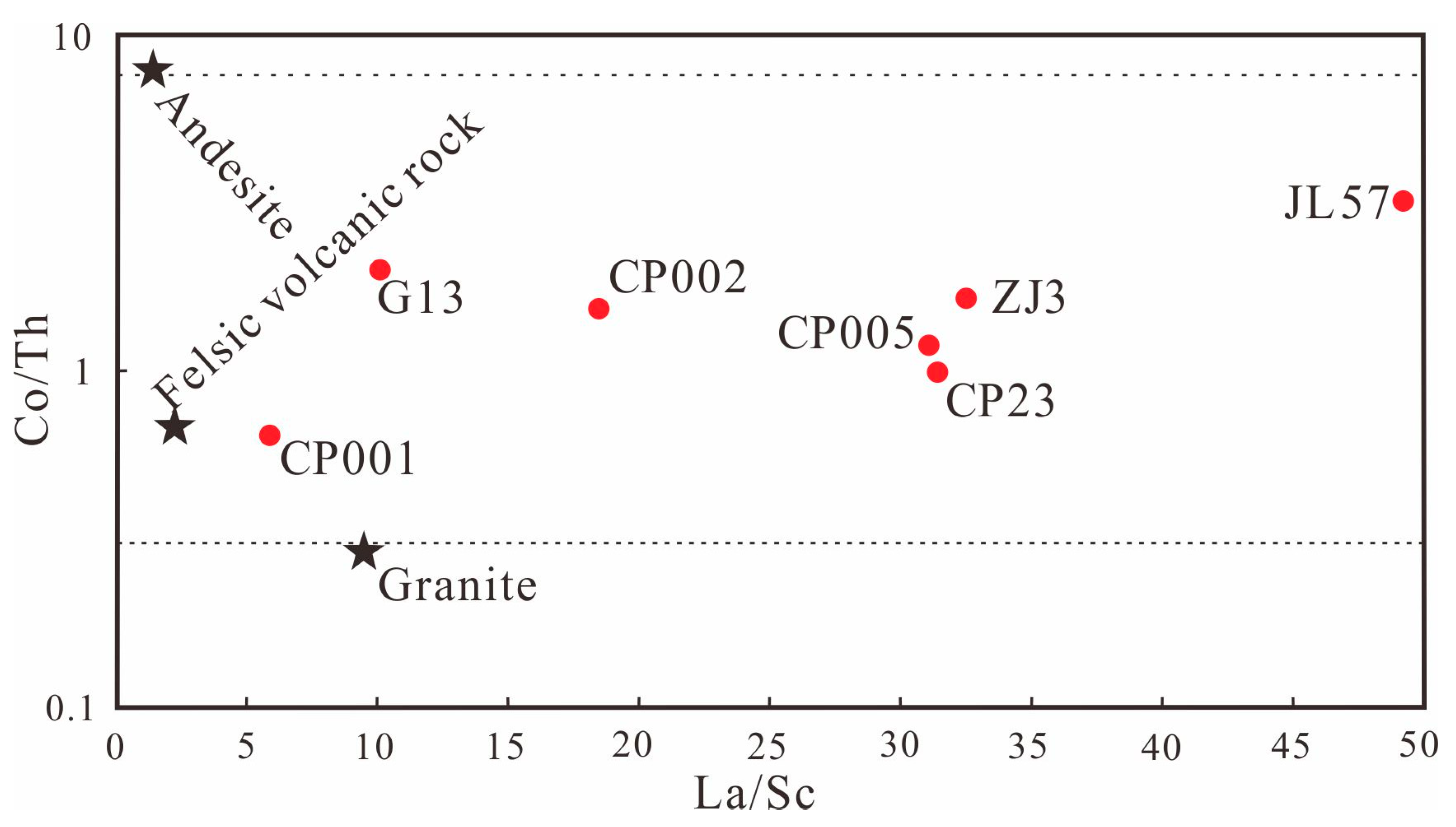



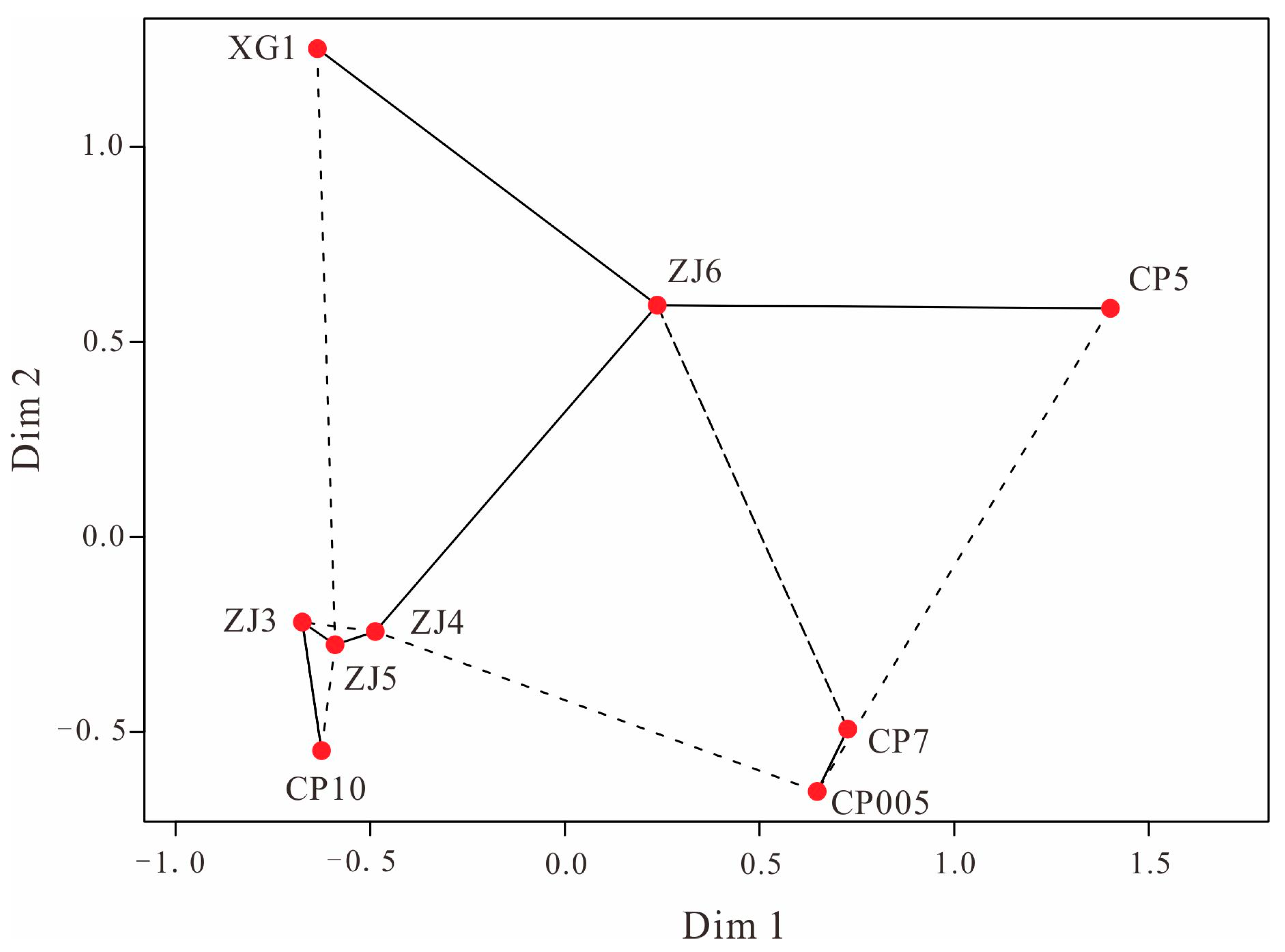

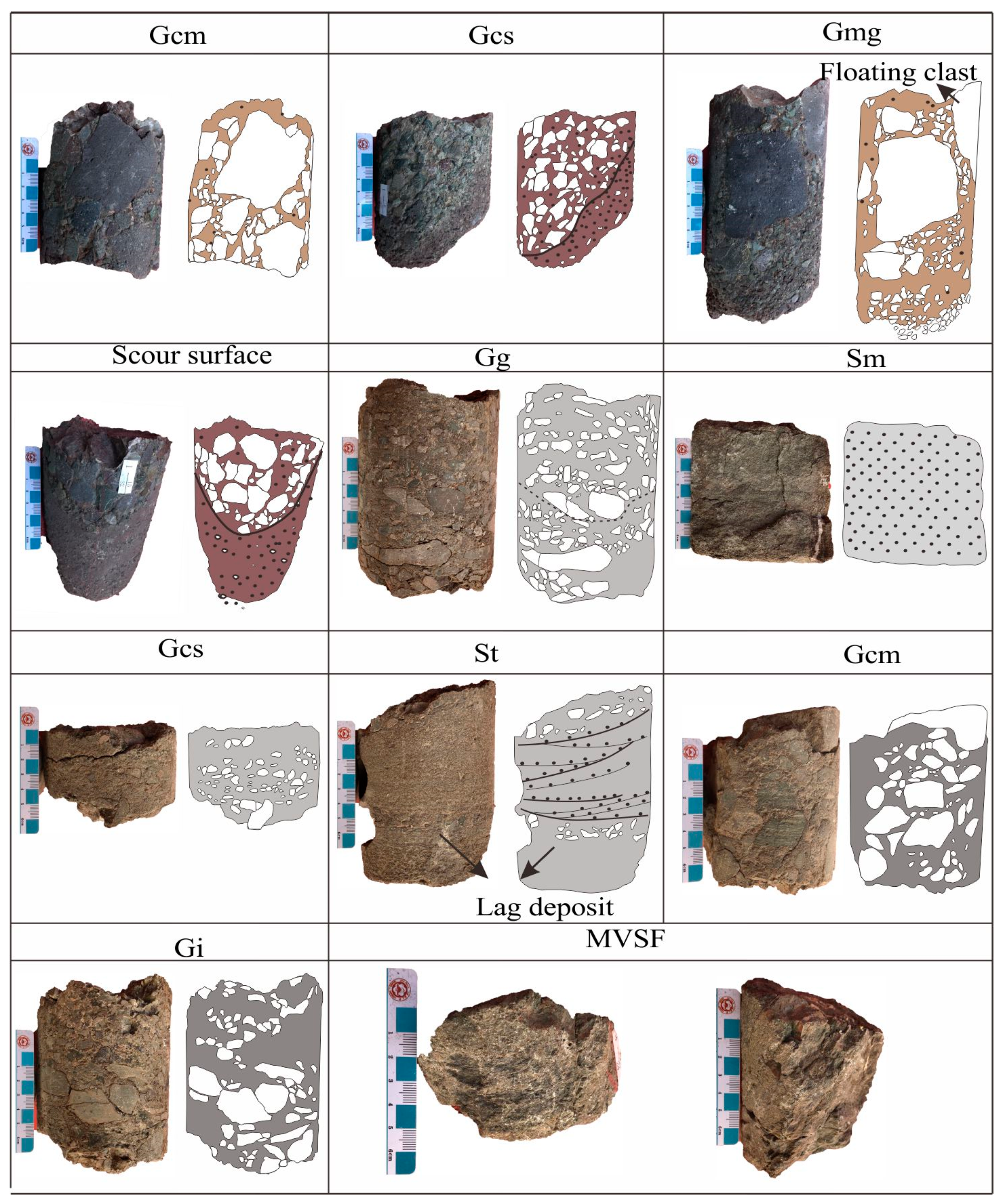




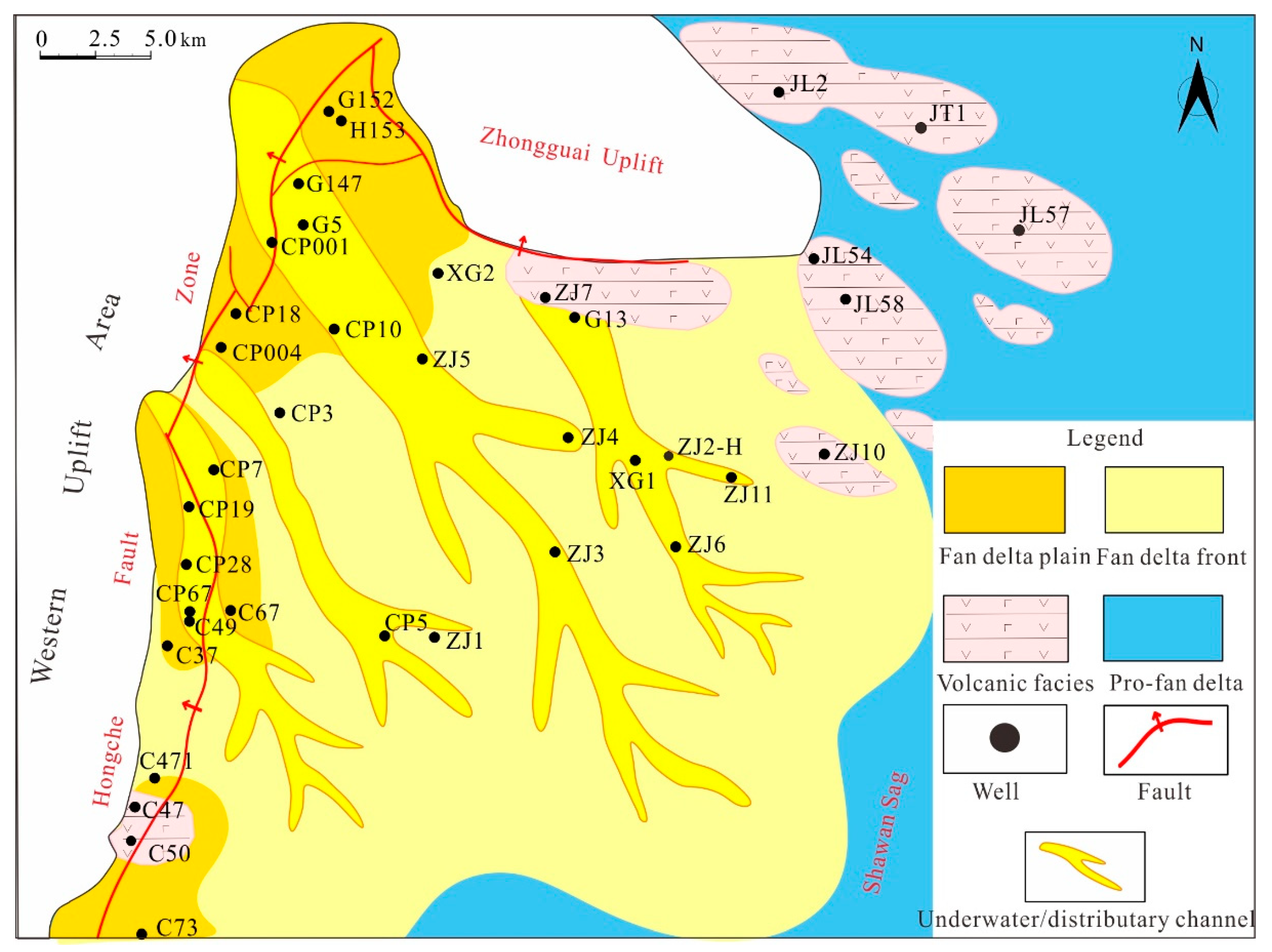
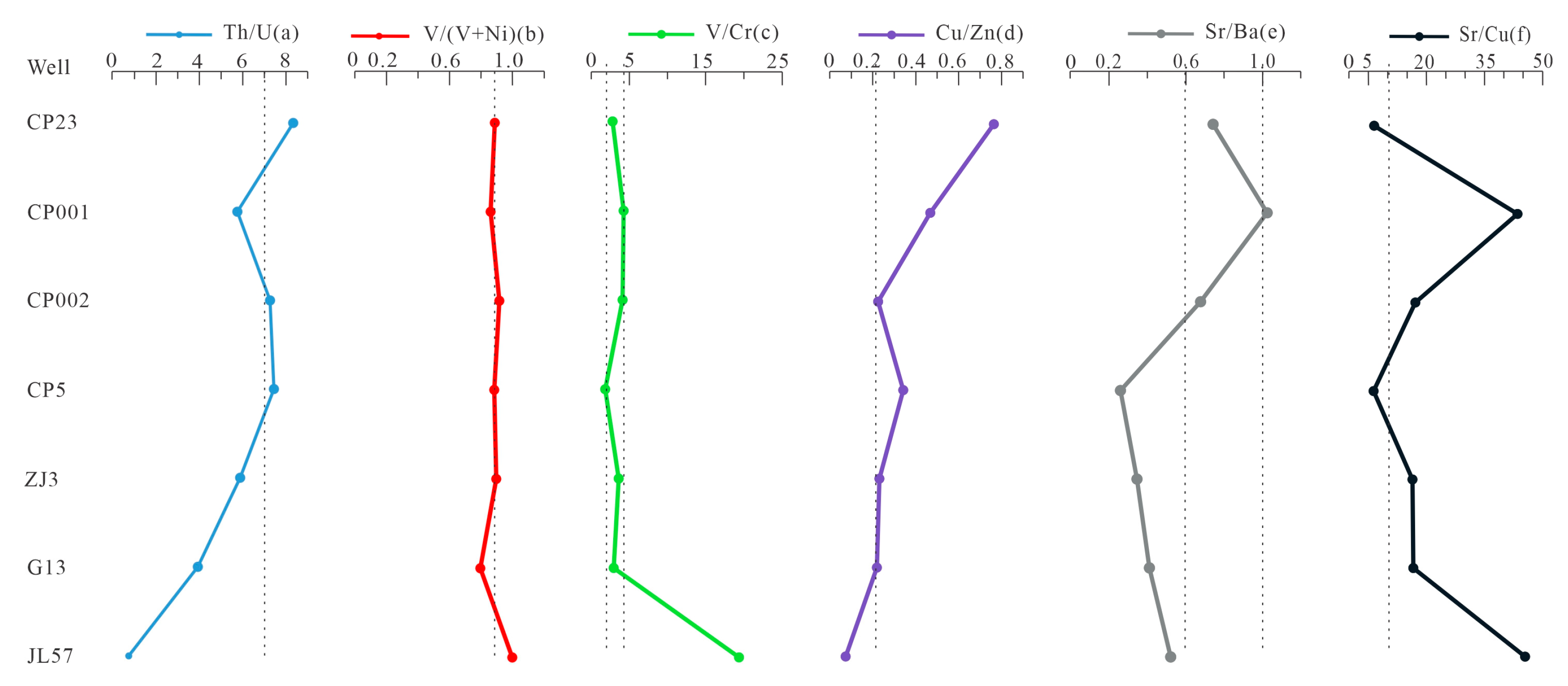

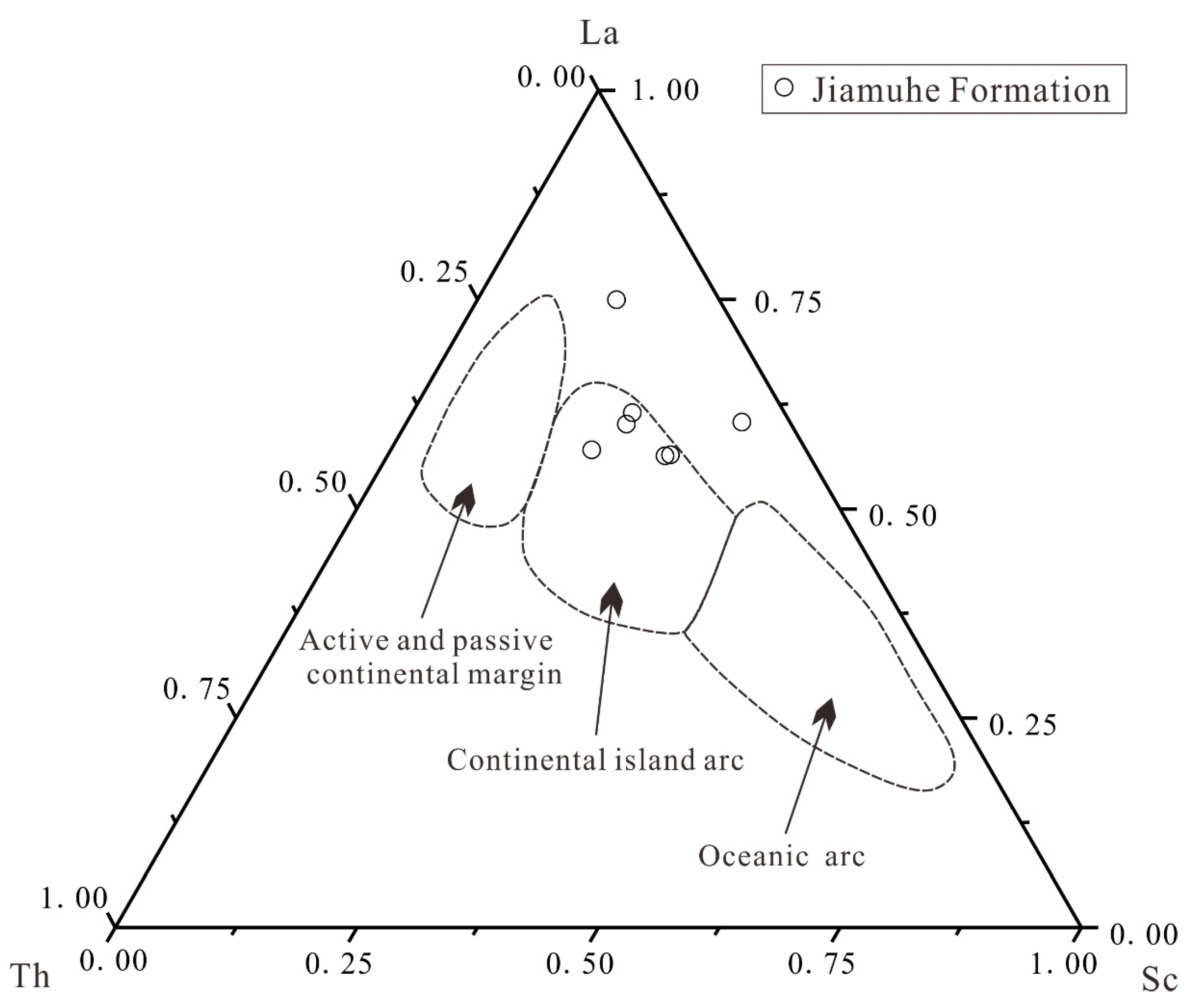
| Well | CP23 | CP002 | CP5 | ZJ3 | G13 | CP001 | JL57 | Average |
|---|---|---|---|---|---|---|---|---|
| Depth (m) | 2023.50 | 2775.10 | 4733.22 | 4955.00 | 4130.76 | 2331.90 | 5301.20 | |
| Pb | 6.90 | 9.04 | 12.07 | 11.52 | 13.38 | 15.19 | 13.03 | 11.59 |
| Zn | 33.36 | 71.08 | 85.02 | 67.89 | 53.29 | 55.02 | 52.09 | 59.68 |
| Cr | 27.08 | 26.00 | 73.22 | 29.07 | 24.95 | 14.83 | 5.95 | 28.73 |
| Co | 5.82 | 10.28 | 9.21 | 10.76 | 12.62 | 6.73 | 8.93 | 9.19 |
| Rb | 19.32 | 39.77 | 54.75 | 58.50 | 69.38 | 64.67 | 15.10 | 45.93 |
| Sr | 164.13 | 269.41 | 177.12 | 249.65 | 186.69 | 1117.25 | 159.77 | 332.0 |
| V | 75.92 | 105.79 | 129.11 | 101.89 | 70.63 | 62.66 | 107.58 | 93.37 |
| Sc | 8.05 | 13.72 | 10.39 | 12.67 | 9.14 | 9.82 | 20.62 | 12.06 |
| U | 0.71 | 0.93 | 1.04 | 1.12 | 1.62 | 1.82 | 4.34 | 1.65 |
| Th | 5.91 | 6.72 | 7.72 | 6.56 | 6.31 | 10.46 | 2.93 | 6.66 |
| La | 41.81 | 26.48 | 27.29 | 24.81 | 24.67 | 26.9 | 35.84 | 29.69 |
| Ce | 37.77 | 41.2 | 40.07 | 36.82 | 43.31 | 41.34 | 79.51 | 45.72 |
| Pr | 6.61 | 5.9 | 5.97 | 5.3 | 4.87 | 5.3 | 10.44 | 6.34 |
| Nd | 26.9 | 27.3 | 25.36 | 24.02 | 21.5 | 22.02 | 49.35 | 28.06 |
| Sm | 5.33 | 6.88 | 5.2 | 5.64 | 4.63 | 4.42 | 11.52 | 6.23 |
| Eu | 1.44 | 1.64 | 1.35 | 1.51 | 1.16 | 1.07 | 3.88 | 1.72 |
| Gd | 4.55 | 5.3 | 4.45 | 4.36 | 3.51 | 3.47 | 10.44 | 5.15 |
| Tb | 0.83 | 1.01 | 0.81 | 0.8 | 0.59 | 0.64 | 1.88 | 0.94 |
| Dy | 4.79 | 5.76 | 4.26 | 4.75 | 5.63 | 3.94 | 11.41 | 5.79 |
| Ho | 0.86 | 1.2 | 0.85 | 1.00 | 0.66 | 0.78 | 2.25 | 1.09 |
| Er | 2.52 | 3.76 | 2.67 | 3.01 | 2.02 | 2.52 | 6.73 | 3.32 |
| Tm | 0.37 | 0.55 | 0.39 | 0.43 | 0.32 | 0.41 | 1.03 | 0.50 |
| Yb | 2.2 | 3.53 | 2.56 | 3.22 | 2.31 | 2.99 | 7.46 | 3.47 |
| Lu | 0.38 | 0.61 | 0.42 | 0.49 | 0.39 | 0.45 | 1.25 | 0.57 |
| Rb/Sr | 0.12 | 0.15 | 0.31 | 0.23 | 0.37 | 0.06 | 0.09 | 0.19 |
| Th/U | 8.34 | 7.25 | 7.42 | 5.85 | 3.88 | 5.74 | 0.67 | 5.59 |
| La/Th | 7.07 | 3.94 | 3.53 | 3.78 | 3.91 | 2.57 | 12.25 | 5.29 |
| La/Sc | 5.19 | 1.93 | 2.63 | 1.96 | 2.70 | 2.74 | 1.74 | 2.70 |
| Th/Sc | 0.73 | 0.49 | 0.74 | 0.52 | 0.69 | 1.06 | 0.14 | 0.62 |
| Sc/Cr | 0.30 | 0.53 | 0.14 | 0.44 | 0.37 | 0.66 | 3.69 | 0.88 |
| Th/Co | 1.02 | 0.65 | 0.84 | 0.61 | 0.50 | 1.55 | 0.33 | 0.79 |
| ΣREE | 136.35 | 131.10 | 121.63 | 116.16 | 115.56 | 116.25 | 232.99 | 139 |
| L/H | 7.26 | 5.04 | 6.42 | 5.43 | 6.49 | 6.65 | 4.49 | 5.97 |
| Ce/Ce* | 0.52 | 0.78 | 0.76 | 0.76 | 0.93 | 0.83 | 0.99 | 0.80 |
| Eu/Eu* | 0.87 | 0.80 | 0.84 | 1.67 | 0.85 | 1.54 | 1.75 | 1.19 |
| La/Yb | 18.98 | 7.50 | 10.68 | 7.70 | 10.66 | 8.99 | 4.81 | 9.90 |
| (La/Yb)N | 12.82 | 5.07 | 7.22 | 5.20 | 7.20 | 6.07 | 3.25 | 6.69 |
| (La/Yb)UCC | 1.20 | 0.47 | 0.68 | 0.49 | 0.67 | 0.57 | 0.30 | 0.63 |
| Well | Total Mass of Heavy Minerals (g) | Terrigenous Mineral (%) | ||||||||||
|---|---|---|---|---|---|---|---|---|---|---|---|---|
| Perovskite | Magnetite | Zircon | Limonite | Pyroxene | Spinel | Epidote | Augite | Garnet | Ilmenite | Sphene | ||
| C90 | 0.03 | 0.24 | 16.08 | 0.68 | 66.33 | 0.22 | 0.00 | 2.40 | 0.11 | 0.16 | 11.54 | 0.00 |
| CP7 | 0.73 | 0.00 | 10.14 | 0.00 | 20.80 | 0.00 | 0.00 | 0.00 | 69.11 | 0.00 | 0.00 | 0.00 |
| CP5 | 1.54 | 1.72 | 6.05 | 0.69 | 0.18 | 87.22 | 0.02 | 73.92 | 5.18 | 0.25 | 0.13 | 0.04 |
| CP10 | 0.30 | 0.19 | 9.67 | 0.11 | 1.75 | 0.00 | 0.00 | 0.01 | 0.00 | 0.00 | 0.00 | 0.09 |
| CP26 | 0.01 | 2.95 | 36.35 | 0.42 | 44.03 | 0.00 | 0.00 | 0.00 | 1.71 | 0.21 | 0.00 | 0.00 |
| CP005 | 0.12 | 1.34 | 47.36 | 0.30 | 2.45 | 0.00 | 0.00 | 0.00 | 41.72 | 0.26 | 0.00 | 0.10 |
| ZJ3 | 0.60 | 7.51 | 8.29 | 0.02 | 5.65 | 72.88 | 0.03 | 0.59 | 0.00 | 0.05 | 4.57 | 0.12 |
| ZJ4 | 1.39 | 1.54 | 22.61 | 0.04 | 22.71 | 49.88 | 0.02 | 0.08 | 0.00 | 0.01 | 1.93 | 0.14 |
| ZJ5 | 0.23 | 1.48 | 22.11 | 0.36 | 0.75 | 60.85 | 0.09 | 0.57 | 0.00 | 0.23 | 11.86 | 0.00 |
| ZJ6 | 3.68 | 6.04 | 10.50 | 0.39 | 57.61 | 0.00 | 0.01 | 15.82 | 0.52 | 0.08 | 5.51 | 0.04 |
| XG1 | 1.86 | 0.37 | 0.62 | 1.74 | 7.94 | 0.00 | 0.07 | 0.81 | 0.00 | 0.37 | 62.54 | 0.51 |
| Category | Heavy Mineral Assemblage | Q-Type Cluster | PCA | MDS |
|---|---|---|---|---|
| I | Pyroxene plus magnetite | ZJ3, ZJ4, ZJ5, and CP10 | ZJ3, ZJ4, ZJ5, CP10, and ZJ6 | ZJ3, ZJ4, ZJ5, and CP10 |
| II | Augite plus limonite | CP7 and CP005 | CP7 and CP005 | CP7 and CP005 |
| III | Limonite plus magnetite plus ilmenite | ZJ6 and ZJ1 | XG1 | ZJ6 and XG1 |
| IV | Epidote plus magnetite plus augite | CP5 | CP5 | CP5 |
| Tectonic Setting | Oceanic Island Arc | Continental Island Arc | Active Continental Margin | Passive Margins | Jiamuhe Formation |
|---|---|---|---|---|---|
| Pb | 6.9 ± 1.4 | 15.1 ± 1.1 | 24 ± 1.1 | 16 ± 3.4 | 11.59 |
| Th | 2.27 ± 0.7 | 11.1 ± 1.1 | 18.8 ± 3.0 | 16.7 ± 3.5 | 6.66 |
| Sc | 19.5 ± 5.2 | 14.8 ± 1.7 | 8 ± 1.1 | 6 ± 1.4 | 12.06 |
| V | 131 ± 40 | 89 ± 13.7 | 48 ± 5.9 | 31 ± 9.9 | 93.37 |
| Co | 18 ± 6.3 | 12 ± 2.7 | 10 ± 1.7 | 5 ± 2.4 | 9.19 |
| Zn | 89 ± 18.6 | 74 ± 9.8 | 52 ± 8.6 | 26 ± 12 | 58.68 |
| La | 8.72 ± 2.5 | 24.4 ± 2.3 | 33 ± 4.5 | 33.5 ± 5.8 | 29.68 |
| Ce | 22.53 ± 5.9 | 50.5 ± 4.3 | 72.7 ± 9.8 | 71.9 ± 11.5 | 45.72 |
| Nd | 11.36 ± 2.9 | 20.8 ± 1.6 | 25.4 ± 3.4 | 29 ± 5.03 | 28.06 |
| Rb/Sr | 0.05 ± 0.05 | 0.65 ± 0.33 | 0.89 ± 0.24 | 1.19 ± 0.40 | 0.19 |
| Th/U | 2.1 ± 0.78 | 4.6 ± 0.45 | 4.8 ± 0.38 | 5.6 ± 0.7 | 5.59 |
| La/Th | 4.26 ± 1.2 | 2.36 ± 0.3 | 1.77 ± 0.1 | 2.20 ± 0.47 | 5.29 |
| La/Sc | 0.55 ± 0.22 | 1.82 ± 0.3 | 4.55 ± 0.8 | 6.25 ± 1.35 | 2.70 |
| Th/Sc | 0.15 ± 0.08 | 0.85 ± 0.13 | 2.59 ± 0.5 | 3.06 ± 0.8 | 0.63 |
| Sc/Cr | 0.57 ± 0.16 | 0.32 ± 0.06 | 0.30 ± 0.02 | 0.16 ± 0.02 | 0.87 |
| Tectonic Settings Provenance Type | Oceanic Island Arc and Undissected Magmatic Arc | Continental Island Arc and Dissected Magmatic Arc | Andean-type Continental Margin (Uplifted Basement) | Passive Margins (Craton Interior and Tectonic Highlands) | Jiamuhe Formation |
|---|---|---|---|---|---|
| La | 8 ± 1.7 | 27 ± 4.5 | 37 | 39 | 29.69 |
| Ce | 19 ± 3.7 | 59 ± 8.2 | 78 | 85 | 45.72 |
| Eu/Eu* | 1.04 ± 0.11 | 0.79 ± 0.13 | 0.6 | 0.56 | 1.19 |
| ΣREE | 58 ± 10 | 146 ± 20 | 186 | 210 | 139 |
| L/H | 3.8 ± 0.9 | 7.7 ± 1.7 | 9.1 | 8.5 | 5.97 |
| La/Yb | 4.2 ± 1.3 | 11.0 ± 3.6 | 12.5 | 15.9 | 9.90 |
| (La/Yb)N | 2.8 ± 0.9 | 7.5 ± 2.5 | 8.5 | 10.8 | 6.69 |
Disclaimer/Publisher’s Note: The statements, opinions and data contained in all publications are solely those of the individual author(s) and contributor(s) and not of MDPI and/or the editor(s). MDPI and/or the editor(s) disclaim responsibility for any injury to people or property resulting from any ideas, methods, instructions or products referred to in the content. |
© 2023 by the authors. Licensee MDPI, Basel, Switzerland. This article is an open access article distributed under the terms and conditions of the Creative Commons Attribution (CC BY) license (https://creativecommons.org/licenses/by/4.0/).
Share and Cite
Yao, Z.; Yu, H.; Yang, F.; Jianatayi, D.; Zhang, B.; Li, T.; Jia, C.; Pan, T.; Zhang, Z.; Aibibuli, N.; et al. Provenance, Depositional Environment, and Paleoclimatic Conditions of a Near-Source Fan Delta: A Case Study of the Permian Jiamuhe Formation in the Shawan Sag, Junggar Basin. Minerals 2023, 13, 1251. https://doi.org/10.3390/min13101251
Yao Z, Yu H, Yang F, Jianatayi D, Zhang B, Li T, Jia C, Pan T, Zhang Z, Aibibuli N, et al. Provenance, Depositional Environment, and Paleoclimatic Conditions of a Near-Source Fan Delta: A Case Study of the Permian Jiamuhe Formation in the Shawan Sag, Junggar Basin. Minerals. 2023; 13(10):1251. https://doi.org/10.3390/min13101251
Chicago/Turabian StyleYao, Zongquan, Haitao Yu, Fan Yang, Deleqiati Jianatayi, Boxuan Zhang, Tianming Li, Chunming Jia, Tuo Pan, Zhaohui Zhang, Naibi Aibibuli, and et al. 2023. "Provenance, Depositional Environment, and Paleoclimatic Conditions of a Near-Source Fan Delta: A Case Study of the Permian Jiamuhe Formation in the Shawan Sag, Junggar Basin" Minerals 13, no. 10: 1251. https://doi.org/10.3390/min13101251





